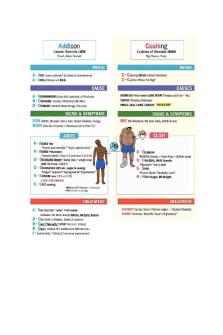Nurse Sarah (Addison\'s Disease vs. Cushing\'s Syndrome) PDF

| Title | Nurse Sarah (Addison\'s Disease vs. Cushing\'s Syndrome) |
|---|---|
| Course | Acute Care 2 |
| Institution | ECPI University |
| Pages | 3 |
| File Size | 55.4 KB |
| File Type | |
| Total Downloads | 43 |
| Total Views | 149 |
Summary
RegisteredNurseRN...
Description
Nurse Sarah (Addison's Disease vs. Cushing's Syndrome) The key players of Addison’s disease and Cushing’s syndrome is adrenal cortex and steroid hormones (aldosterone and cortisol). Function of adrenal cortex: releases corticosteroids and sex hormones. Function of aldosterone: regulates blood pressure though renin angiotensin-aldosterone system, retention of sodium, and secretes potassium. Function of cortisol (stress hormone): helps body deals with stress, increases blood glucose, breaks down fats, proteins, carbs, and regulates electrolytes. Hypothalamus releases CRH causing the pituitary gland release ACTH causing the adrenal cortex to release cortisol.
Cushing's Syndrome/Disease
1
Pathophysiology: o Increase secretion of cortisol. Cushing syndrome is caused by an outside cause due to medical treatment such as glucocorticoid therapy. Cushing disease is caused by an inside source such as producing too much cortisol (pituitary gland secreting too much ATCH). Signs/Symptoms: o Fragile skin (bruise easily). o Truncal obesity. o Round face (moon face). o Reproductive issues (women: irregular menstruation, men: erectile dysfunction). o Ecchymosis. o Elevated blood pressure. o Striae in the extremities and abdomen (looks like purple stretch marks). o Hyperglycemia. o Excessive body hair especially women (hirsutism). o Dorsocervical fat pad (buffalo hump). o Depression (due to high cortisol levels and appearance). Nursing Management: o Prep for hypophysectomy to remove the pituitary tumor. o Prep patient for adrenalectomy. Educate patient about cortisol replacement therapy after surgery. o Monitor for hyperglycemia, hypokalemia, infections, skin breakdown, and provide emotional support.
Addison's Disease
Pathophysiology: o Decreased secretion of cortisol and aldosterone. Caused by autoimmune causing the body to attack the renal cortex due to cancer, TB, hemorrhage and trauma. Signs/Symptoms: o Hypoglycemia. o Hyponatremia (salt cravings). o Tired and muscle weakness. o Electrolyte imbalance (hyperkalemia and hypercalcemia). o Reproductive changes (women: irregular periods and men: erectile dysfunction). o Low blood pressure (at risk for shock). o Increased pigmentation (hyperpigmentation of the skin). o Diarrhea. o Nausea. o Depression. Nursing Management: o Monitor for hypoglycemia and hyperkalemia. o Wear a medical alert bracelet (at risk for Addisonian crisis and pass out). o Eat diet high in protein, carbs, and sodium. o Avoid stress, illness, and strenuous exercise. o Medical Treatments: Administer hormone replacement therapy for cortisol (prednisone and hydrocortisone). Notify health provider of illnesses, upcoming surgeries, or extra stress in life will need to increase dose. Take medication as directed do not stop abruptly. To replace aldosterone fludrocortisone (Florinef) may be prescribed. Increase salt intake.
Addisonian Crisis
2
Pathophysiology: o Occurs when patients aren’t taking their medication, or the dosage is too low. They have low cortisol levels, and this is life threatening. Signs/Symptoms: o Sudden pain in stomach, back, and legs. o Syncope (going unconscious). o Shock. o Super low blood pressure. o Severe vomiting, diarrhea, and headache.
3
Treatments: o IV cortisol (Solu-Cortef) to replace low cortisol levels and IV fluids (D5 normal saline) to increase blood pressure, blood sugar, fluid status, and sodium. o Monitor patients for infection....
Similar Free PDFs

Addisons vs Cushings
- 1 Pages

Addisons disease concept map
- 4 Pages

1. Addison\'s vs. Cushings
- 1 Pages

Addison Cushings notes
- 4 Pages

Cushings examination OSCE
- 2 Pages

CUSHING SYNDROME
- 36 Pages

Syndrome Myelodysplasique
- 3 Pages

Eagle Syndrome
- 2 Pages

Syndrome d’hospitalisme
- 2 Pages

Syndrome Mononucleosique
- 2 Pages

DOWN SYNDROME
- 19 Pages

Syndrome Parkinsonien
- 6 Pages
Popular Institutions
- Tinajero National High School - Annex
- Politeknik Caltex Riau
- Yokohama City University
- SGT University
- University of Al-Qadisiyah
- Divine Word College of Vigan
- Techniek College Rotterdam
- Universidade de Santiago
- Universiti Teknologi MARA Cawangan Johor Kampus Pasir Gudang
- Poltekkes Kemenkes Yogyakarta
- Baguio City National High School
- Colegio san marcos
- preparatoria uno
- Centro de Bachillerato Tecnológico Industrial y de Servicios No. 107
- Dalian Maritime University
- Quang Trung Secondary School
- Colegio Tecnológico en Informática
- Corporación Regional de Educación Superior
- Grupo CEDVA
- Dar Al Uloom University
- Centro de Estudios Preuniversitarios de la Universidad Nacional de Ingeniería
- 上智大学
- Aakash International School, Nuna Majara
- San Felipe Neri Catholic School
- Kang Chiao International School - New Taipei City
- Misamis Occidental National High School
- Institución Educativa Escuela Normal Juan Ladrilleros
- Kolehiyo ng Pantukan
- Batanes State College
- Instituto Continental
- Sekolah Menengah Kejuruan Kesehatan Kaltara (Tarakan)
- Colegio de La Inmaculada Concepcion - Cebu



